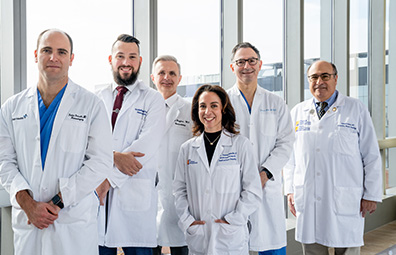Skull Base Tumors and Conditions
The skull base is a crowded and complicated area at the bottom of the skull, which has bony openings that allow the spinal cord, blood vessels, and nerves of the brain stem to pass through. The skull base includes the bones and cartilage that form the face, eye socket, roof of the nasal cavity, some of the sinuses, inner ear, and the junction with the spinal column.

Meet Our Brain Tumor Care Team
Meet the specialists at the Gerald J. Glasser Brain Tumor Center who are experts in treating skull base tumors and conditions.
Meet the TeamSkull base tumors and conditions are some of the most challenging, complex and technically demanding to treat. They require the advanced expertise of highly skilled neurosurgeons and otolaryngologists (ENT) due to their location — on the underside of the brain, the base of the skull and the upper spinal column. Our experienced team treats:
Other Conditions We Treat
Cholesteatoma – a non-cancerous skin lined cyst. Located in the middle ear, it can invade the mastoid bone in the skull base and develop infections.
Chondrosarcoma – a type of bone cancer that originates in cartilage cells. It can occur at the base of the skull and spine.
Epidermoid tumor – a non-cancerous, slow-growing lesion. This tumor develops when normal developing embryonic cells get trapped within the growing brain or spinal cord.
Glomus tumor – a non-cancerous slow growing tumor that arises from glomus bodies. It can develop in the middle ear and jugular bulb of the skull base or carotid artery in the neck.
Hemifacial spasm – a nervous system condition that causes involuntary muscle spasms on one side of the face. It happens when the facial nerve is compressed by a blood vessel at the base of the skull.
Juvenile nasopharyngeal angiofibroma (JNA) – a non-cancerous vascular tumor of the nasal cavity. It is often found in adolescent boys and young men.
Nasopharyngeal carcinoma – a cancerous tumor that develops in the nasopharynx, or upper part of the throat and back of the nose.
Olfactory neuroblastoma – a cancerous tumor (also called esthesioneuroblastoma) that originates from the nasal cavity, where nerves that provide the sense of smell. It often grows along the roof of the nose and involves the skull base.
Schwannoma – a type of non-cancerous nerve sheath tumor that forms from the Schwann cells that produce the insulating layer around nerves cells. It can develop on nerves of the skull base and the rest of the body.
Treatment
Depending on the particular location and structures involved within the skull base, our skull base neurosurgeons collaborate with a team of experts in otolaryngology (ENT), ophthalmology, neuro-radiology, radiation oncology and medical oncology. Patients are evaluated by a multidisciplinary team for the least invasive approach or combination of approaches including open microsurgery, trans-nasal endoscopic surgery and stereotactic radiosurgery (CyberKnife®).